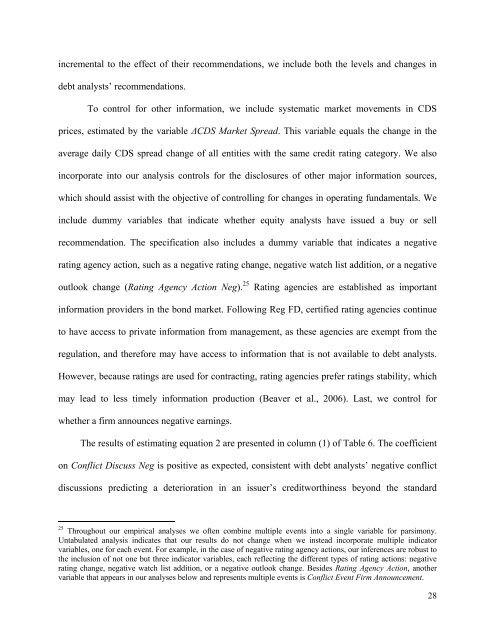Debt Analysts' Views of Debt-Equity Conflicts of Interest
Debt Analysts' Views of Debt-Equity Conflicts of Interest
Debt Analysts' Views of Debt-Equity Conflicts of Interest
Create successful ePaper yourself
Turn your PDF publications into a flip-book with our unique Google optimized e-Paper software.
incremental to the effect <strong>of</strong> their recommendations, we include both the levels and changes in<br />
debt analysts’ recommendations.<br />
To control for other information, we include systematic market movements in CDS<br />
prices, estimated by the variable ΔCDS Market Spread. This variable equals the change in the<br />
average daily CDS spread change <strong>of</strong> all entities with the same credit rating category. We also<br />
incorporate into our analysis controls for the disclosures <strong>of</strong> other major information sources,<br />
which should assist with the objective <strong>of</strong> controlling for changes in operating fundamentals. We<br />
include dummy variables that indicate whether equity analysts have issued a buy or sell<br />
recommendation. The specification also includes a dummy variable that indicates a negative<br />
rating agency action, such as a negative rating change, negative watch list addition, or a negative<br />
outlook change (Rating Agency Action Neg). 25 Rating agencies are established as important<br />
information providers in the bond market. Following Reg FD, certified rating agencies continue<br />
to have access to private information from management, as these agencies are exempt from the<br />
regulation, and therefore may have access to information that is not available to debt analysts.<br />
However, because ratings are used for contracting, rating agencies prefer ratings stability, which<br />
may lead to less timely information production (Beaver et al., 2006). Last, we control for<br />
whether a firm announces negative earnings.<br />
The results <strong>of</strong> estimating equation 2 are presented in column (1) <strong>of</strong> Table 6. The coefficient<br />
on Conflict Discuss Neg is positive as expected, consistent with debt analysts’ negative conflict<br />
discussions predicting a deterioration in an issuer’s creditworthiness beyond the standard<br />
25 Throughout our empirical analyses we <strong>of</strong>ten combine multiple events into a single variable for parsimony.<br />
Untabulated analysis indicates that our results do not change when we instead incorporate multiple indicator<br />
variables, one for each event. For example, in the case <strong>of</strong> negative rating agency actions, our inferences are robust to<br />
the inclusion <strong>of</strong> not one but three indicator variables, each reflecting the different types <strong>of</strong> rating actions: negative<br />
rating change, negative watch list addition, or a negative outlook change. Besides Rating Agency Action, another<br />
variable that appears in our analyses below and represents multiple events is Conflict Event Firm Announcement.<br />
28
















